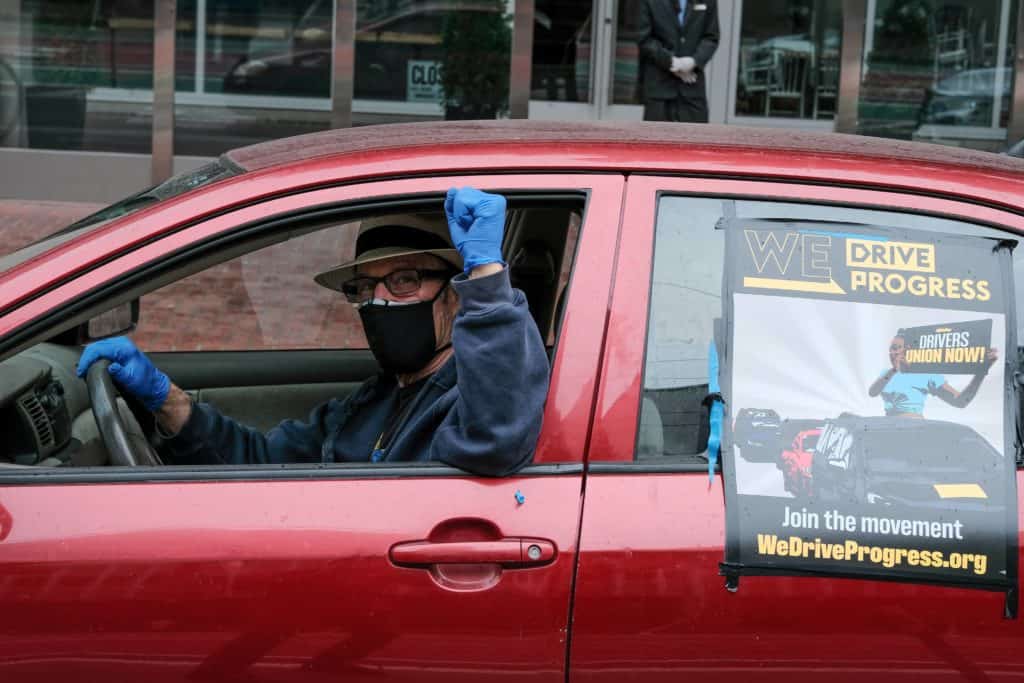When you’re designing your safety incentive program for truck drivers, you’ll want to keep a few things in mind.
Consider the perceived benefit to your drivers and how it could help achieve your company goals. The best driver incentive programs strike a balance between the two.
Whether you’re looking to create your first driver reward program or tweak your existing one, we’ve come up with a few ideas to help you put together one that suits your company.
What Are the Best Types of Truck Driver Incentive Programs?
You should have a good understanding of what motivates your fleet of drivers and inspires them to perform their best. Listen to what their needs are and learn about what encourages them to exemplify great driver behavior.
Once you understand this, you’ll be able to put together a relevant driver incentive program that effectively boosts the performance of your fleet drivers.

Think about what areas you’d like your drivers to improve upon.
- Are your fuel efficiency numbers not being met?
- Are your truck drivers failing to meet on-time deliveries?
- Is driver turnover too high?
- Is the company culture not where you’d like it to be?
These are great questions to ask yourself when designing incentives to encourage improvement in driver behaviors.
Increase in Compensation
For most driver incentive programs, the easiest way to increase success is to increase compensation. You can reward your truck drivers with cash if they achieve a specific goal within a given time frame or achieving certain safety goals.You can use the Driveri Smart Camera to help manage those metrics.
These employees can receive an additional check on top of their normal paycheck or receive an increase in their hourly rate. Cash reward programs are the most common way to motivate your team. One way to prevent driver shortages is to encourage incentives to increase pay as they hit certain milestones within the company.
Provide Recognition Awards
Recognition awards will last a lifetime, and the sense of appreciation they get will last longer than a bonus would. Many employees will forget about their bonus or financial reward once some time has passed. Reward your best drivers with the GreenScore award from our Driveri Camera Safety program.
Offer Catalog Programs
Many companies will have driver incentive programs where drivers can accumulate points overtime each time they hit a certain milestone. Eventually, they can choose to redeem items in a catalog. These types of programs are more likely to change behavior over time.
Your employees may look to acquire a new gadget, and one way to get it is by consistently hitting certain performance and safety metrics.

Disadvantages of Driver Incentive Programs
Keep in mind that your driver incentive program should help achieve your company goals rather than hurt them. You want to make sure that your incentive programs aim to encourage best practices rather than promote conflict.
Drivers Cut Corners
If the incentives in the safety incentive program are considered very lucrative, that could cause drivers to cut corners in their daily driving. As a result, this could actually prevent safe driving and lead to recklessness. Driving recklessly will only cause accidents and lead to even more problems. Use the driveri safety camera to monitor vehicle operation.
When implementing your driver incentive programs, your safety managers should monitor driver behavior. Goals shouldn’t be encouraged at the cost of compliance or safety. If people in your team begin to cut corners, your safety managers can hold safety meetings for all drivers or perform driver coaching.
Unhealthy Level of Competition
As mentioned earlier, you want to strike a good balance with your safety incentive programs. You want to encourage each driver to give their best effort and improve performance. However, you don’t want drivers to undercut each other to get the rewards. The last thing you want is to inadvertently cause an unhealthy place where people can’t get along.
Your Team is Starting to Disengage
When developing your safety incentive programs, make sure that all of the rules are fair. If your fleet of drivers starts believing that the goal is unattainable, you’ll start losing them, and they’ll become disengaged.
This would be a bad outcome for the driver incentive program. It would negatively impact the morale of your drivers and make it hard to fulfill your duties to ensure proper fleet management.

Safety Incentive Programs Implementation
As an organization, you need to implement your fleet management strategies that foster fairness. You don’t want your safety incentive program to create new problems unintentionally.
Promote Fairness
Fairness should be an integral part of your culture. Depending on the types of drivers and the variety of runs you have, you can take a scaled or tiered approach.
Your drivers’ incentive program should make each driver feel like they are a part of the team and feel a sense of belonging to achieving the company goals.
When it comes to fairness, every driver should feel like they work at a place where there is equal opportunity to achieve success in the company and be promoted.
Measure Consistently
In the trucking industry, tracking progress is the key to success. Your organization should be able to measure the progress to ensure you are producing quality drivers.
This means that all of the things in the incentive program are clear so that the results can be clearly measured. At the end of the given time frame, every driver should see where they land in terms of their goals.
One way to measure progress is to use a driver scorecard. Every time a driver achieves a goal, they will score points. And if they perform a dangerous act on the road, that will negatively affect their driver scorecard.
How Do I Incentivize My Truck Driver?
It’s quite common that you may lose a quality driver based on poor coaching or not enough incentives to keep them around. Here are a few tips to motivate your drivers in your fleet:
Create Opportunities to Move Up Within the Company
Make it clear that certain behaviors will be rewarded. This can include meeting goals, having good ratings, and having seniority within the organization. With a higher position, drivers can get access to more coveted jobs or more favorable routes.
Have a Mentoring Program

You can have your newest drivers partner up with more senior drivers, so they can have their questions answered and have a resource to go to. On the other hand, experienced drivers will feel like they are improving the company’s culture and shaping the future for new drivers.
Reward and Recognize Top Performers
Rather than threatening your drives to reduce violations and idle times, you should reward drivers who work hard and hit their goals consistently. You can give the spotlight and name the individual who showed exemplary driving behavior. Other incentives such as gift cards and time off can also make a huge impact.
Ask for Feedback
Create surveys and have an open door policy where drivers can ask questions or have their concerns addressed. These drivers can remain anonymous if they choose and won’t have to give out their names. Drivers will know that you listen to their suggestions and take action to resolve the situation.
Why Should You Offer Driver Incentives?
Fleets who meet safety standards will have a high fleet carrier ISS score. Having a program that encourages safety for your fleet of drivers will result in a more positive brand reputation, fewer vehicle crashes, reduced cargo issues, minimized injuries, lower fleet insurance costs, less driver turnover, and a higher rate of satisfied clients.
A safety incentive program will provide rewards to drivers who achieve certain goals or perform positive acts in the business. This includes having safe driving records, passing any roadside inspections, pointing out positive vehicle observations, and performing proper safe driving practices measured by GPS telematics devices.
There is also a network effect when your entire fleet is looking to follow the best safety practices. For example, a person who would normally perform bad driver behaviors such as rapid acceleration and aggressive braking may start thinking twice.
If their peers are tracking their safety and performance progress, they will want to save themselves from embarrassment. Nobody wants to be singled out for driver coaching.

When Should You Offer Driver Incentives?
Your business can use three incentive periods for their incentive programs: Monthly, quarterly, or annually. With a yearly rewards program, one single violation can eliminate a quality driver from earning rewards. However, with a monthly or quarterly award, everyone in your team has a great chance to be recognized some time during the year.
Some fleets will have training programs to reward their drivers throughout the year continually. For example, any time a driver in your fleet performs a positive act on the road, they will receive a small prize such as a $10 gift card.
This includes coaching a less experienced driver, helping a team member with an issue with their vehicle, displaying excellent customer service to your clients, and attending a large number of non-mandatory types of driving coaching or training meetings.
How Should You Offer Driver Incentives?
Rewards for rewarding safety needs to be both attainable and meaningful for fleets. This will vary based on your company culture, location, and type of fleet. For one program, a meaningful cash incentive maybe $3,000 to $4000, while for another company, it could only be $500 to $600 per year for having a clean driving record.
The number will vary based on your company’s threshold and perceived value of the reward. Some drivers may enjoy and work hard to receive a simple $100 quarterly bonus for passing a clean roadside inspection.
What Should You Offer Drivers As an Incentive?
A successful fleet rewards program may include various types of criteria and incentive plans for earning. Monetary benefits are great, but recognition awards give the driver a sense of pride for following safety practices.
You could also use tools such as giving special signage to the driver’s vehicle, announcing that they have driven over 100,000 miles and stayed accident-free. As each driver takes pride, this creates a team-based culture where everyone is happy and feels like their at home. This type of culture makes it hard for a driver to leave the company.
Do Truck Drivers Get Bonuses?
The hiring manager may typically post content within the trucking sector about various sign-on bonuses that are offered. You may typically see numbers such as $2,000, $4,000, $8,000 and $10,000.
These companies create a hiring program to attract new drivers for their recruitment strategy. Since there is such as big shortage of drivers, many trucking companies will use a reward program and a sign-on bonus program to attract and keep as many drivers as possible.
However, the driver won’t receive the full bonus until they receive certain performance goals or driven a set number of miles and finished the company’s coaching or driver training program.
Final Thoughts
Truck driver incentive programs should help your business achieve its goals while also help drivers to feel recognized. The rewards that companies give should reward positive workplace practices and make drivers feel recognized.
When your fleet of drivers feels a sense of belonging and satisfaction, this will lead to better driver retention, fewer accidents, and cheaper insurance policies. There are many types of rewards and incentives that you can implement, and it may take some time to understand your driver’s needs.
Once you are ready to build out an incentive program for your organization, make sure that all the things in the program are clear and fair. Find out how our solutions at Ascent Fleet Services can help.

1 thought on “Truck Driver Incentive Programs”
Im very happy to find this web site. I want to to thank you for ones time just for this fantastic read!! I definitely appreciated every part of it and i also have you saved as a favorite to see new information in your blog.